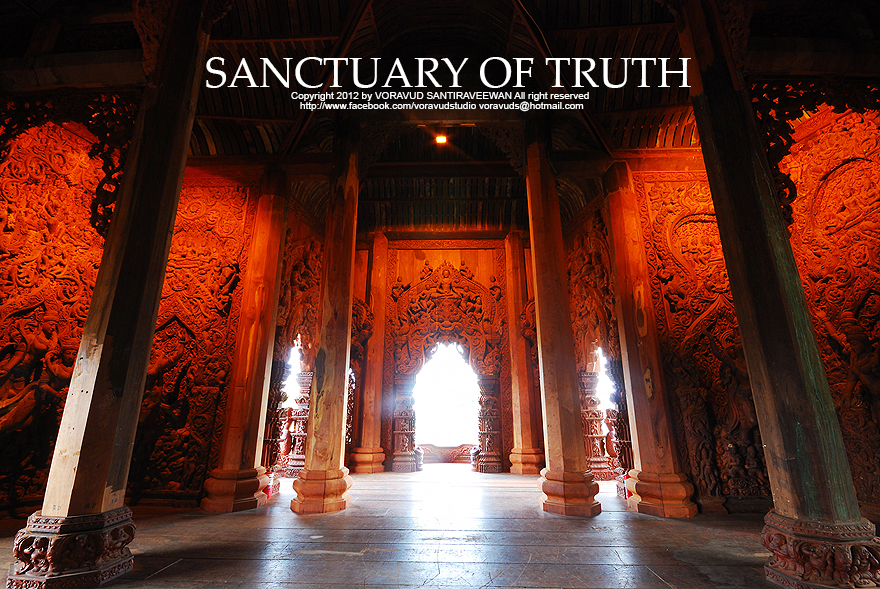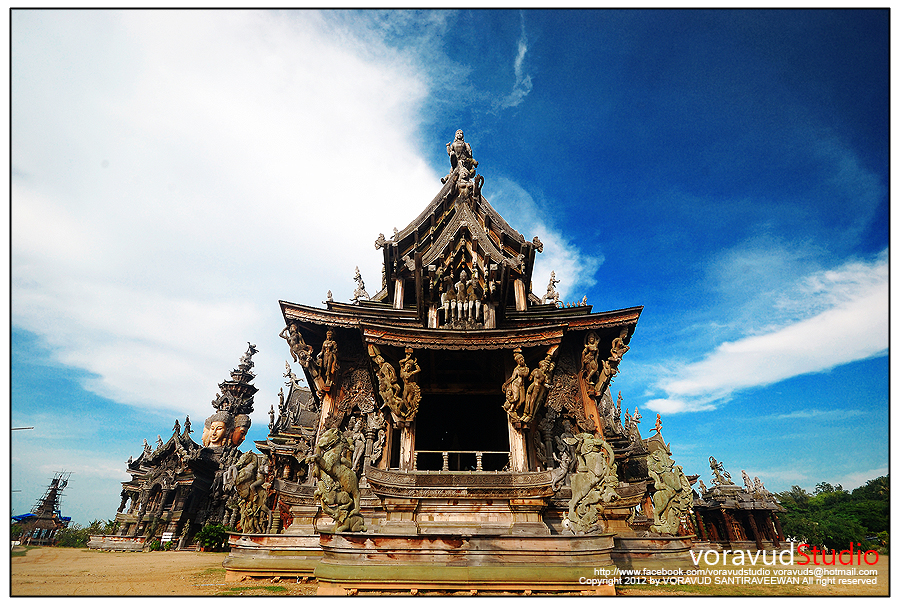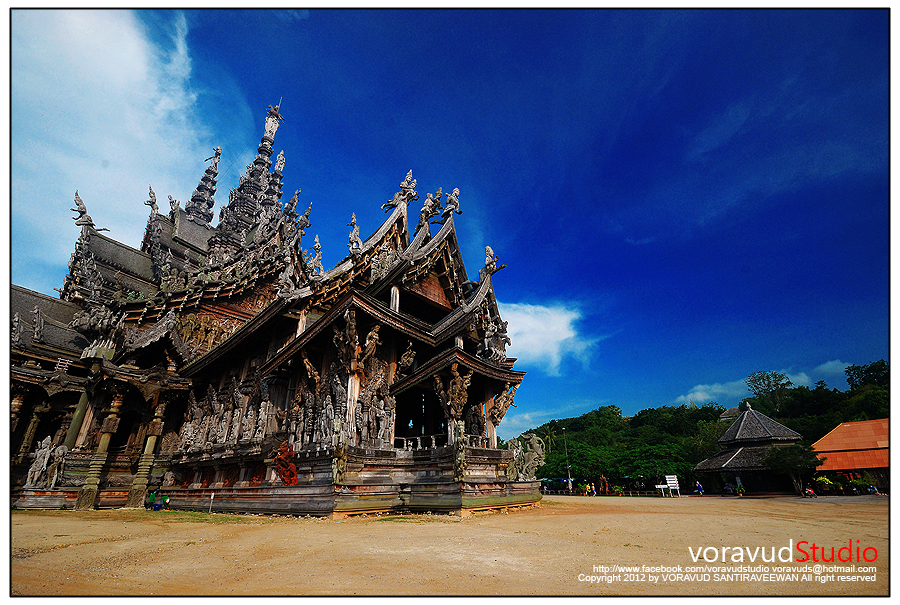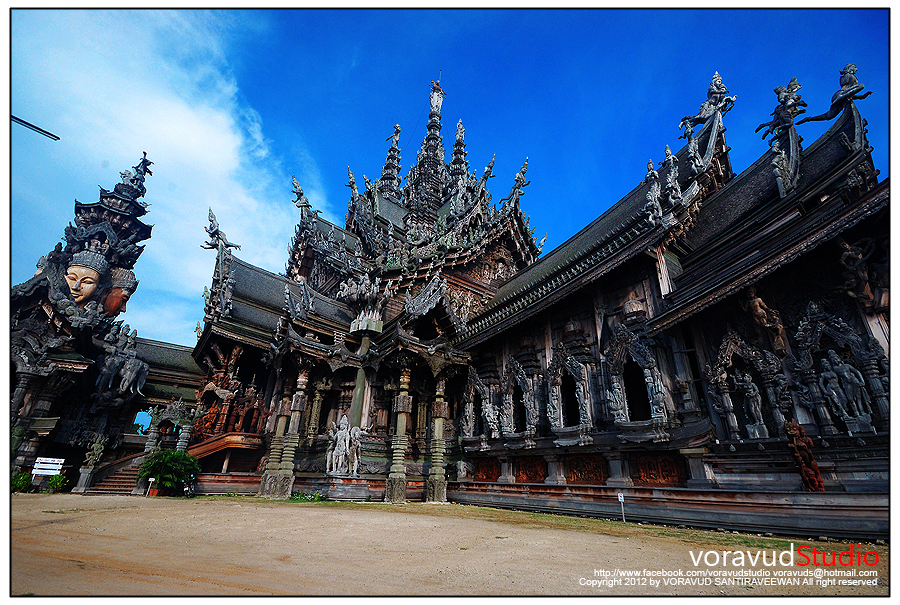Today, I was lucky enough to visit one of the places I've always wanted to see. I've seen pictures and heard about its magnificence for a long time, and it's finally here: the Sanctuary of Truth.

The Sanctuary of Truth is located in the Laem Ratchawet area of Na Kluea Subdistrict, covering an area of 80 rai. It is renowned as the "world's largest wooden structure." Locals often refer to it as the "Ancient Palace" or, based on its materials, the "Wooden Castle." However, the man behind the concept and construction, Lek Viriyaphant (founder of Ancient City in Samut Prakan Province), named it the "Sanctuary of Truth."




The Sanctuary of Truth began construction in 1981 and is still not completed. The castle is built entirely of wood, with no metal or concrete, except for the concrete base. The traditional Thai wood joinery system or wooden mortise and tenon is used. The castle is a four-sided pyramid, 100 meters high and 100 meters wide, with intricate carvings both inside and out. It is said to be as beautiful as a divine creation, reflecting abstract concepts and making them tangible, conveying the importance of Eastern religion and philosophy.



According to the history of the Sanctuary of Truth, Mr. Srisak Vallibotama, an art consultant to Mr. Lek, mentioned in http://www.paknam.com that
The Sanctuary of Truth is related to the land that Sia Lek bought, which is a very beautiful area. He therefore saw that something useful should be done in the Pattaya area, which is full of material prosperity. Sia Lek felt uncomfortable, so he had the idea of doing something that would go against the grain of a world that was only interested in creating bad objects, such as weapons.
"He also wanted to counter the trend of creating weapons by creating something good for the world, both in terms of religion and philosophy. It would be beneficial, but the way he communicated, he chose to communicate through art. This is Khun Lek's idea, but Khun Lek's way of thinking never thought of creating greatness for himself. He did not want to be a leader in religion or philosophy, but he wanted to take what philosophers, scholars, and various sages had given that was beneficial to the world, bring it together, and then bring it together as the Sanctuary of Truth. That is, to bring it together and cook it in one place."



Professor Srisakorn acknowledged the ability of Mr. Lek to communicate the philosophy of the world through art. Mr. Lek chose to build the Sanctuary of Truth, using art as a medium. What Mr. Lek created was not something new, but rather something old that was reinterpreted and expressed through art.

"The purpose of visiting the castle is not to see it as art, but to see its meaning. It is to see art as a medium, to see it in terms of goodness and philosophy. He started by making a model before actually doing it, but the model is not fixed. It can be flexible and changed. That is, Khun Lek will gradually do it and adjust it as appropriate. Therefore, the Sanctuary of Truth is not finished immediately. It has to be gradual."
According to A. Sri Sakorn, the Sanctuary of Truth is a place where visitors can witness the movements of various deities. The intricate designs are meticulously copied from various sources, including books, carvings, and murals from different locations. The sanctuary incorporates elements from Khmer, Buddhist, Hindu, Islamic, and Chinese art, blending them together to create symbolic representations that convey the intended meaning.
"The core of truth is the center, which is the pavilion. However, the pavilion is empty because it means that if humans behave according to the Dharma, they can be there. The center of the Sanctuary of Truth is emptiness. This is Khun Lek's idea."





To put it simply, the castle's body resembles a plus sign (+) facing the sea. At the center, where the plus sign intersects, sits the previously mentioned pavilion. The total height of the castle, including the spire, is 105 meters.
The construction of the castle is based on the belief that humans are born and live with seven essential elements: the sky, the earth, the father, the mother, the sun, the moon, and the stars. These elements are represented through wood carvings within the castle. Additionally, humans have four virtues that they must practice in order to reach the ideal world of the Ariya era, which is the era in which the last Buddha, the fifth in the Bhadrakalpa, will attain enlightenment. As depicted in the wood carving at the top, this era is represented by the figure of Phra Kalki (an avatar of Vishnu who descends as a white horse knight or a man named Kalki, wielding a powerful sword to vanquish evil and establish a new system of righteousness, ensuring everlasting happiness for society and the nation).




The remaining four virtues are symbolized by wooden carvings on the top of each side of the building, namely:
Angels holding lotus flowers symbolize grounding the world - Religion
The angel carrying the child and leading the elderly symbolizes giving life to humans - continuation.
Angel holding a book means continuous immortal philosophy - wisdom
An angel with a dove perched on its hand signifies peace for the world.



The Sanctuary of Truth aims to bring people together to realize the seven origins and four virtues that will make the ideal world a reality. Even if it is a small world specific to individuals or the whole world, there will be obstacles to achieving the ideal world. Therefore, there is a fight between good and evil, good and bad, high and low minds. The creator has expressed through the wood carving of the Ramayana and Mahabharata epics to serve as a warning and to guide humans to cleanse their desires and cravings. Because there is no victory greater than conquering oneself.



As mentioned, the castle itself resembles a plus sign, so it is divided into four sides.
Side 1: The side facing the sea
This side serves as a gateway for visitors, with a large, intricately carved four-faced Brahma statue adorning the gable.



This side of the castle will have carvings of the three gods, namely
Brahma: The god who created the universe and the world
Brahma is the first god in the Trimurti (Brahma, Vishnu, and Shiva). According to the scriptures, Brahma has a red body, four faces, and four arms. He holds a scepter, rosary beads, a water pot, or a bow and arrow. He sits on a lotus throne and rides a swan as his vehicle.



Shiva, also known as Ishvara: The god of destruction and creation.
In the very beginning, Brahma created the world and the universe. However, many problems arose in the human world, so Shiva destroyed the world. Later, Shiva created the world again and appointed Vishnu to take care of it.


Vishnu or Narayana: The god who protects and preserves the world.
According to the Puranas, Lord Shiva created the world. However, maintaining peace and harmony in the world was a more challenging task. Therefore, Lord Shiva created Lord Vishnu to assist him in this endeavor. During the creation of the world, Lord Vishnu incarnated ten times to help subdue the forces of evil. These incarnations were: Fish, Tortoise, Boar, Narasimha, Vamana, Parashurama, Rama, Krishna, Buddha, and Kalki.


Day 2: Gods of the Day of Birth
This side features carvings of the seven deities representing each day of the week.


Section 3: Lord and Lady of the House
This reminds us of the kindness of our parents.

Side 4: This side can be called the "Pantheon of Gods", featuring numerous sculptures of various deities.







Next to the Sanctuary of Truth, there is a model of the castle used for planning repairs and extensions.

I stayed to take pictures until the evening, the light was gone. Let me stop here for now.



Credit information and articles from
Follow our work at
http://www.facebook.com/voravuds
http://www.facebook.com/voravudstudio
Voravud Santiraveewan
Friday, September 27, 2024 9:53 AM

















